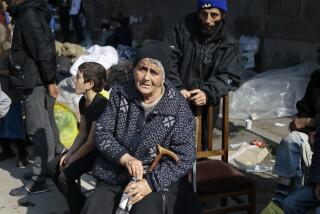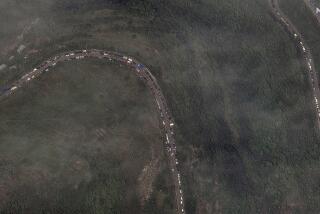A City Lies Poised Between U.S. Troops and the Taliban
TERMEZ, Uzbekistan — From the north bank of the Amu Darya river, Afghanistan lies in the distance, forbidding and unreachable.
The ancient desert city of Termez, the invaders’ gateway to Afghanistan for centuries, is sealed tight against the threat of Taliban attack or a flood of Afghan refugees.
The Soviet Union built what it called the Friendship Bridge across the river here in the 1980s so its tanks and troops could cross easily into Afghanistan. Now the “friendship” is long over, the bridge is closed, and well-armed Uzbek soldiers stand guard, protecting the town from the chaos to the south.
This crossroads of history, once an important junction on the old Silk Road, has become little more than a dusty cul-de-sac.
One hundred thirty miles northwest of here, the United States has gained a foothold in Uzbekistan by stationing more than 1,000 troops at the Khanabad air base. But if the Pentagon plans to send large-scale ground forces into Afghanistan, it won’t be following the route of Genghis Khan and Tamerlane any time soon. There is no hint of a U.S. military buildup near Termez.
“If they were intending to send troops across the border, you would see the signs already, the preparations,” said an Uzbek lieutenant-colonel here.
Instead Termez, a town of 111,000, is as quiet as the sand that relentlessly blows in from the desert.
The American troops at Khanabad have operated under such a heavy veil of secrecy that it is unclear if any of them have stepped off the former Soviet air base in the 10 days since they began arriving.
In Termez, the military presence is all Uzbek: Police operate checkpoints throughout the town, stopping and searching cars at random; border guards routinely stop visitors from taking photographs of the Friendship Bridge or Afghanistan in the distance.
Unexpected Alliance of Harsh Dictator and U.S.
Uzbekistan, a harsh dictatorship still run by its Communist-era boss, Islam Karimov, formed an unexpected alliance with the United States to fight global terrorism after the attacks on New York and the Pentagon.
The former Soviet republic has been the target of bombings allegedly carried out by the Islamic Movement of Uzbekistan, which wants to form an Islamic state in the country’s mountainous northeast. Members of the group, which allegedly has links to Osama bin Laden, are now believed to be fighting on the side of the ruling Taliban in Afghanistan.
After the terror attacks on the United States, Uzbekistan quickly agreed to allow the U.S. to base troops at Khanabad for humanitarian and search-and-rescue missions. Some Special Forces units were deployed along with troops from the 10th Mountain Division, prompting speculation that covert missions could also be launched from the base.
On Friday, the two countries formally signed an agreement in Washington allowing the United States to use the Uzbek military base and the country’s airspace for its operations.
“We will work together to support delivery of humanitarian assistance to the people of Afghanistan,” the governments said in a joint statement. “We also commit ourselves to eliminate international terrorism and its infrastructure.”
According to a report in the Washington Post on Sunday, Uzbekistan and the United States began cooperating in covert operations aimed at countering the Taliban and its terrorist allies more than a year before the Sept. 11 attacks. Details about the nature of the operations could not be learned.
In Termez, many people have a hard time believing that any U.S. troops have landed in the country.
“There are no American military forces here, only humanitarian,” insisted Shakhlo Turdieva, 20, a nurse who was part of a wedding party paying its respects at a mausoleum.
The mausoleum is so close to the border that it is separated from the river only by a barbed-wire fence and a narrow strip of land. Border guards keep watch from a hill next to the mausoleum.
“We’re not worried,” continued Turdieva. “Everything is peaceful here. Weddings are taking place. Even being so close to the border we don’t see anything happening or harm done.”
Safar Yusupov, a 35-year-old accountant who visited the mausoleum to receive a blessing from the imam, was also dubious about the arrival of U.S. troops.
“We haven’t seen any Americans so far, so I don’t think they will be coming,” he said. “Uzbek forces are very strong here, and we don’t need them.”
Town Used to Be Key Point Along Silk Road
Termez, which is said to be 2,500 years old, occupies a key passage between Central Asia and Afghanistan. The terrain is less rugged here, and the river broadens and slows, becoming easier to cross. In ancient times, the town was a major intersection in the network of trade routes known collectively as the Silk Road.
The first known conqueror to subjugate the area was Alexander the Great, who in 329 BC crossed the river, then known as the Oxus, on his way from present-day Iran to the Pamir Mountains.
In 1228, Genghis Khan and his Mongol hordes rode through Termez on their way to conquer present-day Afghanistan. In the 14th century, the ruthless Tamerlane, today an Uzbek national hero, traveled through the town on his way to conquer Afghanistan and plunder India.
The Russians seized Termez in 1890 and made it a key southern outpost of the czar’s empire. When the Soviet Union invaded Afghanistan in 1979, it used Termez as its staging area, and tens of thousands of troops filled the city.
In 1989, when the defeated Soviets pulled out of Afghanistan, Gen. Boris V. Gromov symbolically rode the last armored personnel carrier across the Friendship Bridge and then walked the last few yards. “I did not look back,” he said later.
Today, a row of Soviet-era tanks and artillery pieces that came back with Gromov’s forces line one of Termez’s main streets--a reminder of what happened the last time a great power invaded Afghanistan.
Uzbekistan watched nervously during the 1990s as the strength of the Taliban spread in Afghanistan. In 1997, shortly after the historic Afghan city of Mazar-i-Sharif fell to the Taliban, Uzbekistan closed the Friendship Bridge.
About 1,000 Afghan refugees fleeing the Taliban made it into Termez before the bridge closed.
Some residents say that until the bridge is reopened, Termez will remain a backwater. If peace could prevail in Afghanistan and Pakistan, they say, goods could reach the Indian Ocean, restoring Termez to its historic role as an important trading center.
Today, however, a police officer stands at the northern entrance to the half-mile-long bridge, ordering the few vehicles that come this way to turn back. Behind him, concrete barriers block entry to the bridge. Cotton fields line both sides of the road. Nearby is a faded sign extolling Uzbekistan’s future:
“In the 21st century,” it reads, “our country will reach its place in world economy and culture.”
More to Read
Sign up for Essential California
The most important California stories and recommendations in your inbox every morning.
You may occasionally receive promotional content from the Los Angeles Times.










